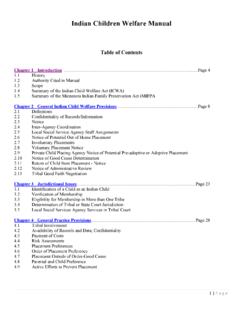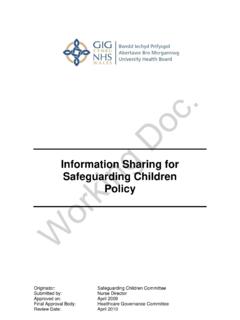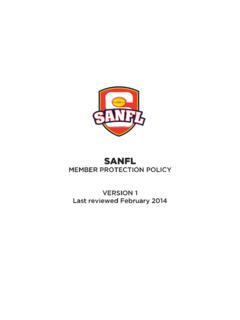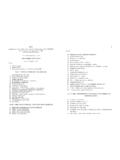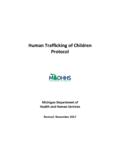Transcription of CHILD PROTECTION POLICY AND PROCEDURES
1 CHILD PROTECTION POLICY AND PROCEDURES . MANDATORY NOTIFICATION OF CHILD ABUSE TO THE DEPARTMENT OF. COMMUNITY SERVICES. From the 18 December 2000, the provisions of the Children and young Persons (Care and PROTECTION ) Act. 1998, will replace those of The Children (Care and PROTECTION Act. 1987, with respect to the Notification of CHILD abuse to the Department of Community Services (DCS). The Key Legislative changes in respective of the Notification of CHILD abuse to DCS are as follows: 1. A person who in the course of his or her professional work or other paid employment in the field of health care, welfare, education, children's services, residential services, or law enforcement, must report to DCS the name of any CHILD when such a person has reasonable grounds to suspect that the CHILD is at Risk of Harm.)
2 2. A new single ground (basis) for Notification, including Mandatory Notification, to DCS will apply being: a CHILD or young person at Risk Of Harm . 3. The Notification process has been redefined and reconceptualised as Reporting Risk of Harm to DCS. 4. Reporting of Risk of Harm will be undertaken using a new, DCS Tele-Service. For Mandated Reporters 133627 24 hour DCS Helpline 5. Risk of harm can arise as a result of: Sexual abuse Physical abuse Psychological harm (emotional abuse). Neglect of basic physical needs Domestic violence Homelessness 6. The Mandatory Reporting of Risk of Harm applies to any CHILD under the age of 16 years. It also applies to a class of children under 16 years of age, see 8 below. 7. Reporting of Risk Of Harm in respect of young persons between the ages of 16 and 18.
3 Years is discretionary. Such Reporting may be mandated by an employer. The Department of Education and Training, NSW, has mandated the reporting of risk of harm in respect of young persons' by all DET staff. 8. Reporting of Risk of Harm applies to both individual children and a class of children or young people . A class of children or young people refers to more than one CHILD or young person who may be at risk of harm because of their association with a person or situation identified as posing a risk of harm. 9. DCS has the authority to direct agencies (including non-government schools) to provide information relating to the safety, welfare and well being of a CHILD or young person or a class of children or young people . It should be noted that while from 18 December 2000.
4 Mandatory Reporting of Risk of Harm will replace Mandatory Notification of CHILD Abuse and all existing PROCEDURES relating to: Role of the School Principal Legal PROTECTION for Reporters (Notifiers). Allegations of CHILD abuse/harm related to the actions of a staff member which remain unchanged from the previous notification process. Summary - When to Report to DCS. The Children and Young Person (Care and PROTECTION ) Act 1998 refers to reports being made when there are reasonable grounds to suspect risk of harm to the CHILD or young person. A. CHILD or young person is at risk of harm if current concerns exist for the safety, welfare and wellbeing of the CHILD or young person because of the presence of one or more of the following circumstances: 1. The CHILD 's or the young persons' basic physical or psychological needs are not being met or at risk of not being met.
5 2. The parent or other carers have not arranged and are unable or unwilling to arrange for the CHILD or young person to receive necessary medical care. 3. Sexually abused or ill-treated. 4. The CHILD or young person is living in a household where there have been incidents of domestic violence and, as a consequence, the CHILD or young person is at risk of serious physical or psychological harm. 5. A parent or other carer has behaved in such a way towards the CHILD or young person that the CHILD or young person has suffered or is at risk of suffering serious psychological harm. (Section 23 children and Young Persons (Care and PROTECTION ) Act 1998). A report can also be made if a CHILD or young person is homeless (Sections 120 and 121. Children and Young Persons (Care and PROTECTION ) Act 1998).
6 For a CHILD this will form part of the risk of harm considerations. For a young person between 16 and 18 years of age, a report relating to homelessness needs to have the agreement of the young person. If a staff member is concerned about a CHILD or young person but is unsure about whether to report, he or she should consult with their principal or manager, or the DCS Helpline, phone 13 3627 . In the context of an ongoing case plan, local DCS staff may also be approached for advice. Where it is suspected that a crime has been committed, irrespective of the age of the victim or the passage of time, the police must be advised. CEC, NSW and CCER will rewrite and reissue their existing Guidelines for Identifying and Notifying CHILD Abuse - Guidelines for Catholic School Personnel.
7 Reporting Young People aged 16-17 Years Under the Children and Young Persons (Care and PROTECTION ) ACT) mandated reporters are only required by law to report risk of harm to children under the age of 16 years. Those working with young people should endeavour to reduce vulnerability to risk of harm through the network of care and support services available. If they have concerns about the level of risk a young person is facing and are unsure if it warrants a report it is important to consult with the Department of Community Services. Where a practitioner is concerned that person aged 16 or 17 years is at risk of harm from abuse or neglect they should make a report. The young person should be involved in the decision to report, and the process of reporting, unless there are exceptional reasons for excluding them.
8 If the young person is against the report being made, this information must be conveyed to the Department of Community Services, which must consider the young person's wishes in any assessments and investigations. Refer: Sections 24, 27 and 31 Children and Young Persons (Care and and PROTECTION ). Act 1998. The needs of young people can vary from the needs of children and workers will need to use their judgment about the risks a young person may face. Young people may be vulnerable because of issues such as hazardous substance abuse, family breakdown or crisis, disability, homelessness or a violent relationship. They may be exhibiting criminal behaviours or be victims of crime. Vulnerable young people are often living with multiple risk factors and engaging in risk taking behaviours themselves.
9 Protective factors will also need to be taken into account when dealing with the issue of reporting risk of harm. For example, a young person may be homeless but because they are in a youth refuge with supportive adults around them they are therefore considered to be safe. If this young person leaves the refuge, the protective factors may disappear and a report may then be warranted. In making a judgment about reporting young people, the risk of harm issues are not always clear. At times it is difficult to differentiate the origins of risk of harm that young people face. For example, a young person may be at risk of harm from hazardous substance abuse or self harming behaviours but it can be difficult to make a judgment as to whether the risky behaviour stems from abuse, neglect or homelessness.
10 Sometimes practitioners may be working with a young person who exhibits a range of indicators or abuse or neglect. The young person may disclose past abuse that has been investigated previously and the matter closed, or they may not have disclosed abuse or neglect but their lifestyle indicates they are experiencing risk of harm from past abuse. In weighing up whether to make a report practitioners need to ask themselves: Can the indicators be linked to risk of harm from abuse and neglect? What will happen if this young person is not reported? How do I negotiate the report with the young person who does not wish to be reported? How can I assist in reducing the risk of harm once the young person is reported? How can I work with the Department of Community Services to ensure that the report has positive outcomes for the young person?
